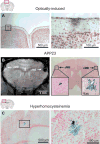Rodent Models of Cerebral Microinfarct and Microhemorrhage
- PMID: 29459393
- PMCID: PMC5851653
- DOI: 10.1161/STROKEAHA.117.016995
Rodent Models of Cerebral Microinfarct and Microhemorrhage
Keywords: arteriole; autopsy; brain; cognitive dysfunction; vascular dementia.
Conflict of interest statement
Figures




References
Publication types
MeSH terms
Grants and funding
LinkOut - more resources
Full Text Sources
Other Literature Sources

